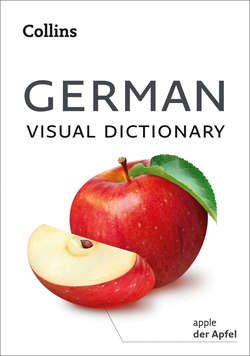Читать книгу Collins German Visual Dictionary - Collins Dictionaries - Страница 5
INTRODUCTION
ОглавлениеWhether you’re on holiday or staying in a German-speaking country for a slightly longer period of time, your Collins Visual Dictionary is designed to help you find exactly what you need, when you need it. With over a thousand clear and helpful images, you can quickly locate the vocabulary you are looking for.
The Visual Dictionary includes:
10 chapters arranged thematically, so that you can easily find what you need to suit the situation
images – illustrating essential items
YOU MIGHT SAY… – common phrases that you might want to use
YOU MIGHT HEAR… – common phrases that you might come across
VOCABULARY – common words that you might need
YOU SHOULD KNOW… – tips about local customs or etiquette
USING YOUR COLLINS VISUAL DICTIONARY
In order to make sure that the phrases and vocabulary in the Collins Visual Dictionary are presented in a way that’s clear and easy to understand, we have followed certain policies when translating:
1) The polite form “Sie” (you) has been used throughout the text as this is always safe to use, even if a bit formal at times, for example:
How old are you? Wie alt sind Sie?
Remember that if you are addressing an older person or someone you have just met in German, you use “Sie”. However, if you are speaking to a child or someone you know well, you can use “du”. If you are speaking to more than one person you know well, you should use “ihr”.
Once you get to know someone, they may suggest that you use “du” instead of the more formal “Sie”.
You can call me “du”. Sie können mich duzen.
2) The grammatical gender of German nouns has been indicated using the articles “der” (masculine), “die” (feminine) and “das” (neuter).
As the article “die” is used for all plural nouns, whatever their gender, all plural translations have been marked with the gender of the singular noun, as well as the plural marker, for example:
potatoes die Kartoffeln fpl
Feminine forms of nouns have been shown with the masculine form as the main translation:
student der Student / die Studentin
3) The basic form of adjectives has been shown for vocabulary items, for example:
green grün
Remember that if the adjective appears before the noun in German it changes depending on whether the noun it describes is masculine, feminine or neuter, and whether it is singular or plural.
a green salad ein grüner Salat
a green jacket eine grüne Jacke
a green dress ein grünes Kleid
green shoes grüne Schuhe
FREE AUDIO
We have created a free audio resource to help you learn and practise the German words for all of the images shown in this dictionary. The German words in each chapter are spoken by native speakers, giving you the opportunity to listen to each word twice and repeat it yourself. Download the audio from the website below to learn all of the vocabulary you need for communicating in German.
www.collinsdictionary.com/resources
